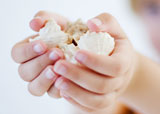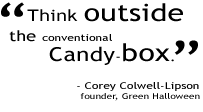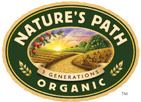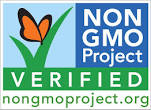FAQ
What is Green Halloween?
What is your definition of “green”?
What makes this Halloween GREEN and not just healthy?
This sounds like a great idea, but what are my kids going to think?
Halloween is one holiday. For the most part, my kids eat just fine. What difference does one day make?
If I’m only going to try one thing this year to make a change in our Halloween, where should I start?
Most of your activities and “treasures” appear to be aimed at young children. What about those who are a bit older or even teenagers. Shouldn’t they be able to participate?
What is Green Halloween?
Green Halloween is a non-profit, grassroots community initiative to create healthier and more Earth-friendly holidays, starting with Halloween. It began in the Seattle area in 2007 with backers such as Whole Foods Market and was such a huge success that in 2008, the initiative expanded nation-wide. In cities across the country, volunteer coordinators are turning their city’s Halloween holiday healthy and eco-friendly, but many are also raising money for their own, local nonprofit beneficiaries via the initiative.
What is your definition of “green”?
Although many people associate greenness with sustainability, we believe that no discussion of sustainability is complete without also discussing healthy people and healthy communities. That’s why we’ve developed the 3 G’s of being green. In our book, doing or choosing one is light green, two is green and three is dark green and therefore ideal. But we also recognize that everyone needs to start somewhere and that busy folks are looking for easy and clear ways to make a difference, so our 3 G’s were also developed to help on-the-go people some simple guidelines.
Green = the 3 G’s
- Good for People – Including the people who make, grow or sell the products we consume or use. Also good for us and our families. Healthy treats and treasures fall under this category.
- Good for Planet – Includes making choices that have the least impact on the Earth during the lifespan (beginning to end) of that choice or product.
- Good for the Community – Including making choices and supporting businesses whose business practices and products support the well being of communities such as via monetary contributions to worthy causes.
What makes this Halloween GREEN and not just healthy?
Going green means making choices that are both people and Earth healthy. Today it is easier than ever to make green choices, even during traditionally non-green holidays such as Halloween. In the past, making kid and Earth friendly Halloween choices meant doing a lot of research and spending a lot of money, but 2007 marked the start of something new: a Halloween that is easy, affordable, fun and oh yes, healthy. In addition, going green also means making the world a better place – so this year, Green Halloween is helping to awareness of and funds for EcoMom Alliance, as well as for other non-profits from coast to coast through local Green Halloween efforts.
This sounds like a great idea, but what are my kids going to think?
Every child is different. Some are already budding environmentalists and are simply looking for guidance from adults about how to apply their passion for the planet into their lives. For these kids, the transition from a traditional Halloween into a green one will likely be easy.
Other children may be upset, disappointed or angry at the idea of giving up what they have known and what they expect. This is completely understandable and is one reason Green Halloween is placing a great deal of emphasis on children in the 1- 5 age ranges. Young children have less concretized expectations of holiday traditions and will generally be open to creating new ones.
Regarding older children, we believe it is important for parents to talk openly with their kids about why they’ve chosen to reduce or eliminate traditional treats. Let your kids know that you care about their health, the health of other people’s children and the health of our planet. Ask them how they feel about the changes and ask them for their ideas on how Halloween can be made healthier and greener. You may be surprised by what they come up with. Be open to incorporating their ideas and encourage them to be involved with the planning of your Green Halloween.
Tweens and teens may be given choices. Perhaps they can do less trick-or-treating and have a party instead. For the party, they can help you choose healthy food and prizes.
This is not an all or nothing situation. As a parent, you can be both a guide and a partner with your child regardless of his age. And remember that your child takes cues from you. If you are excited about new traditions, your child is more likely to be as well. Regardless of their age, you may decide that it’s okay for your child to have some candy. If so, one idea is to allow children to keep a pre-determined amount and then trade the rest for some other things that they enjoy like a book or appropriate CD or some coupons for skating, horseback riding or any other activity they might enjoy.
This is not an all or nothing situation. As a parent, you can be both a guide and a partner with your child regardless of his age. Your child takes cues from you. If you are excited about new traditions, your child is more likely to be as well. And don’t forget that as a parent, it is okay to make the decisions, even if your child is not entirely on board with them.
Lastly – and we know that this might sound surprising – what we’ve found is that it is parents who may actually have a harder time making the change than their children. This may be because in our day, candy actually was a treat, or because children today are quite savvy about health and environmental issues. Parents may remember their own Halloween traditions and want to re-create them for their own children, which is completely understandable. But what we found in 2007 shocked even us: of the thousands of children we met at Green Halloween events, not one child of any age (from two to teen) said that they would rather have conventional candy when they saw the alternatives we were suggesting. Not one.
… so, this year, why not give it a try and see what you and your kids think of going green? Let us know how it goes. We look forward to hearing from you.
Halloween is one holiday. For the most part, my kids eat just fine. What difference does one day make?
We have to start someplace if we want to improve the health of our children and our planet. Halloween is a beginning. It offers a platform for us to focus attention not just on this holiday, but on how we have become consumers of things that do all of us harm. So it’s not about one day, but about changing a lifetime one step and one holiday at a time.
In addition this “one day” calls attention to larger issues such as:
- This generation of kids has a life expectancy that is shorter than their parents.
- The EPA considers that 60% of all herbicides, 90% of all fungicides and 30% of all insecticides found in non-organically grown foods are carcinogenic.
- Over 6,000 synthetic chemicals are used in the processed-food industry.
- A 2004 study found that children’s behavior measurably improved after a one week diet without preservatives and artificial colors and dramatically worsened on the weeks they were given preservatives and artificial colors.
- Coco beans used for chocolate that are grown in full sun (as opposed to shade) are susceptible to disease and therefore require heavy doses of toxic pesticides and synthetic fertilizers.
- The chocolate industry has engaged in the use of child slaves and other unethical treatments of growers.
- Store-bought costumes, makeup and accessories may contain phthalates, cadmium, lead and other toxins.
If I’m only going to try one thing this year to make a change in our Halloween, where should I start?
Start with whatever idea sounds fun to you and your children. Depending on your child’s age, attempting to stop all door to door candy questing can backfire. Instead, talk with your children about the possibilities (assuming they are old enough to have this discussion). Let them decide what they’d like to try first.
With younger children, choose whatever will be simple and easy for you. The main idea is to commit to the concept of Green Halloween
Most of your activities and “treasures” appear to be aimed at young children. What about those who are a bit older or even teenagers. Shouldn’t they be able to participate?
Sure they should. And we welcome them to do so. But because the emphasis on candy and other sweets is so ingrained in the American culture, we believe that our best opportunity lies with the little ones. They haven’t yet learned the connection between Halloween and sweets. If we can raise young children with the idea that Halloween is fun when it’s healthy and green, as they grow up, their expectations will be different. But don’t assume that older kids and teens won’t go for making Halloween healthier and greener. You may just be pleasantly surprised!
Our suggestion for making Halloween green with older children and teens is to meet them half-way. Do they really want to go trick-or-treating (and your neighborhood is not yet green)? As we suggested earlier, a candy trade is one way for kids to enjoy trick-or-treating while earning ‘pumpkin points’ towards something that he or she really wants such as a book, CD, or tickets for a favorite show or activity. Or, ask your child to choose one aspect of Halloween to be green, such as the trick-or-treating, the party food or the decorations. In this way, your child won’t feel overwhelmed with the changes and you, your child and the planet will still benefit from at least one of your Halloween choices.
Teenagers, especially, might enjoy our suggestions for turning Halloween into a way to help people and the planet through initiatives such as Reverse Trick-or-Treating or other Trick-or-Treating for good programs. This way they can still enjoy traditions such as dressing up and going door-to-door, while also making real and positive differences in the world.
Remember that as a parent, it’s okay to make decisions that your children don’t agree with. But we believe that your Green Halloween will be most enjoyable for everyone when parents of older kids communicate openly with their children and start slowly with the adjustments.
We would love to get input from parents with children of all ages about how celebrating a Green Halloween has worked for them. E-mail us with ideas and suggestions.




















